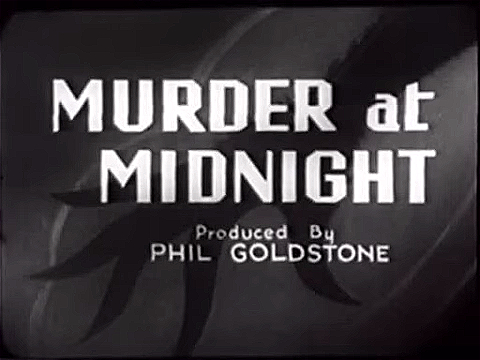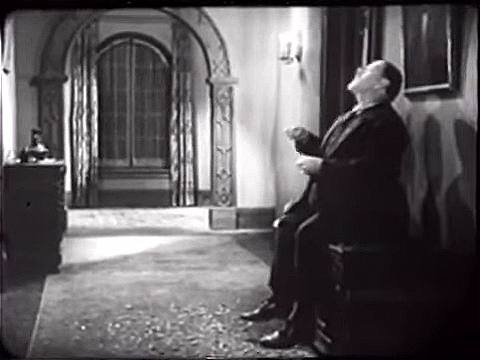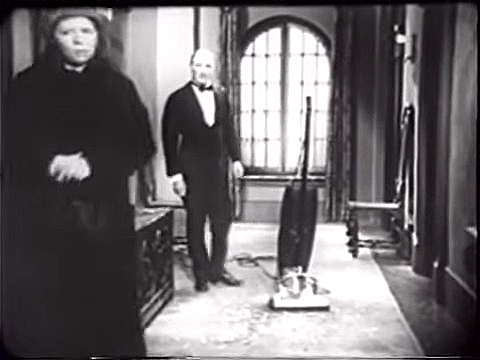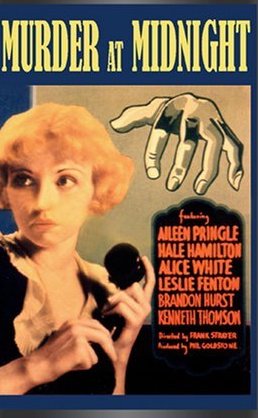Murder at Midnight (1931)
IMDb meta-data is 1 hour and 9 minutes of runtime which is rated 5.4 by 310 cinematizens.
Genre: Mystery
Verdict: Oh hum.

During the Great Depression audiences found the filthy rich playing games. Upstairs there were card games, and downstairs a playlet was enacted. In the play a husband finds his wife in the arms of another man as the hall clock strikes midnight, and hubby pulls from his pyjama pocket the gun he always has with him in bed, and shoots paramour. (Cue NRA applause.) It is all very stagey with the players just barely remembering their lines until…. Bang! That was a nice touch. Then the lights come up and we see the audience sitting around the vast parlour in easy chairs who applaud, with snide asides about the truth in play.
Somehow the playlet is also a word game, and along with everyone else, I didn’t get it. That may be why the playlet is referred to as charades in the IMDb summary and all those that cut-and-paste from it by way of review. But surely no game of charades has dialogue and props that go bang.
The players take a bow, and drinks are served. No one, but argus-eyed viewers like this modest scribe, seems to notice that the ostensible paramour is still lying on the floor for the longest time. In the rush to booze at least one extra stepped over him. The fraternity brothers admired that commitment to Lord Alcohol.
But, yes, Jim, he is dead. Lawyer Monty is present and calls Plod who orders people around, much to the indignation of the filthy rich who cannot see why a murder should interrupt their drinking. More applause from the fraternity brothers at this point.
So far, so bland.
But there are twists for it turns out that the homicide Plod was called before — repeat, before — the playlet was staged and that early phone call said there were two murders, not one. Egads! (This is all confused because the clock was set to midnight to suit the playlet and in the confusion afterward not re-set, until Plod started plodding.)
At that revelation much confusion consumes screen time until another shot is heard. Gadzooks! Plod declares with satisfaction, ‘That’ll be the second body.’ (Nifty.) The plot thickens when a will goes missing. Much lugubrious talking follows. The fraternity brothers snoozed on.

When a supporting player finds a clue and says so, clonk follows as the body count increases. Plod assigns a fraternity brother as a guard and he throws peanut shells on the floor. The butler vacuums up the shells and in so doing finds and hides the will. See if you can guess where. Brandon Hurst plays the butler to a T, as he often did. Later the peanut eating is used to loosen the tongue of a reluctant witness who is a neatnik, and he tells all rather than endure the sight of a fraternity brother throwing peanut shells around. These are a couple of amusing wrinkles.

It’s an early talkie and it shows. It is slow and much the dialogue is delivered to the microphone more than addressing any of the characters.
We never do find out why the neatnik son was so mopey with his millions. ‘Maybe his underwear were too tight,’ ventured the fraternity bothers, voicing one of their recurrent problems.
Ever since the murder of Roger Ackroyd it is always the least suspicious character who is the villain and that applies here. (Though I know of at least one film version of Roger Ackroyd that changed that convention. Alas, nothing is scared.) The means of murdering the last couple of stiffs is ingenious and might have an application for the iPhone. No spoiler on that. It would take too long to explain to the technologically deprived.
Aileen Pringle is top billed in this poverty row production. It was unusual at the time for a woman to be at the top of the bill, but then this is an undistinguished lot, most of whom are best known for this unknown film. Don’t let it go to your head, Aileen.

